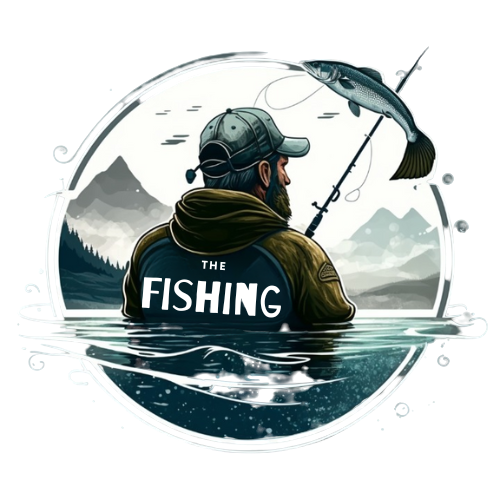What is a fishing leader? A fishing leader is a section of the fishing line that connects the main fishing line to the lure or bait. Leaders are essential components of rigs that serve critical functions for angling success.
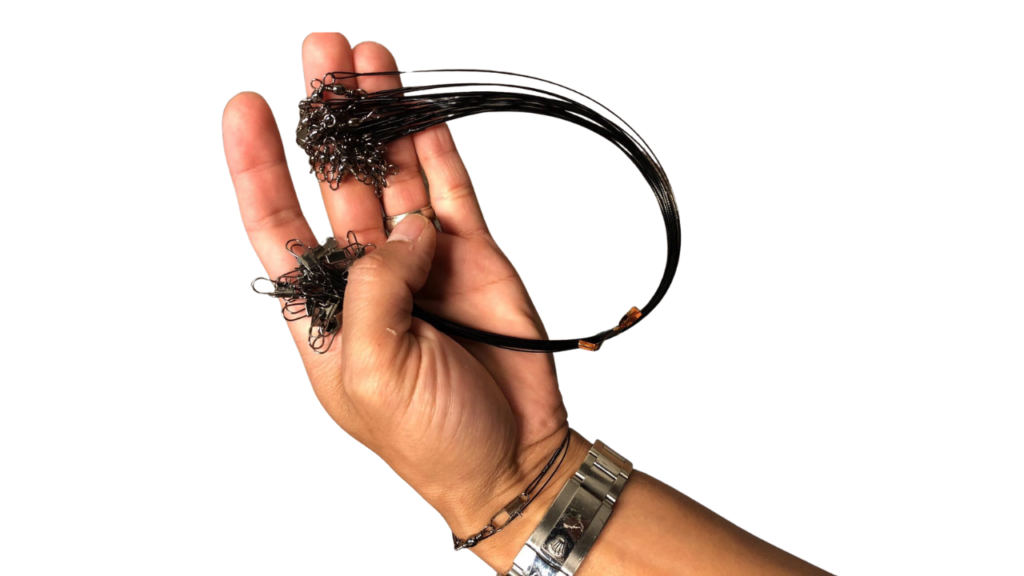
This comprehensive guide will teach you everything you need to know about picking the right leaders and using them effectively.
Table of Contents
- What is the Purpose of a Fishing Leader?
- Leader Position in Fishing Rigs
- Types of Fishing Leader Materials
- Factors in Choosing Leader Strength
- Recommended Leader Lengths
- Specialized Leader Configurations
- Attaching Leaders to Lines and Lures
- Leaders for Bass Fishing
- Leaders for Walleye Fishing
- Leaders for Surf Fishing
- Leaders for Offshore Trolling
- Caring for Leaders and Inspecting for Damage
- Frequently Asked Leader Questions
What is the Purpose of a Fishing Leader?
The leader provides three major benefits for anglers:
Invisibility
The transparent, thin profile of leaders makes them very difficult for fish to see underwater. This prevents wary fish from getting spooked in clear water conditions. Fluorocarbon leaders in particular have refraction properties that perfectly match the light in water.
Sensitivity
Leader materials like fluorocarbon have very low stretch and high sensitivity for detecting bites. You’ll see your line jump when a fish takes the bait.
Durability
Leaders are designed to be abrasion resistant so they don’t get damaged from fish strikes, rocks, timber, and other hazards. This prevents losing fish from compromised lines.
Leader Position in Fishing Rigs
The leader is attached between the main fishing line and the terminal tackle as shown:
Main Fishing Line -> Float -> Leader -> Terminal Tackle (hooks, lures, bait)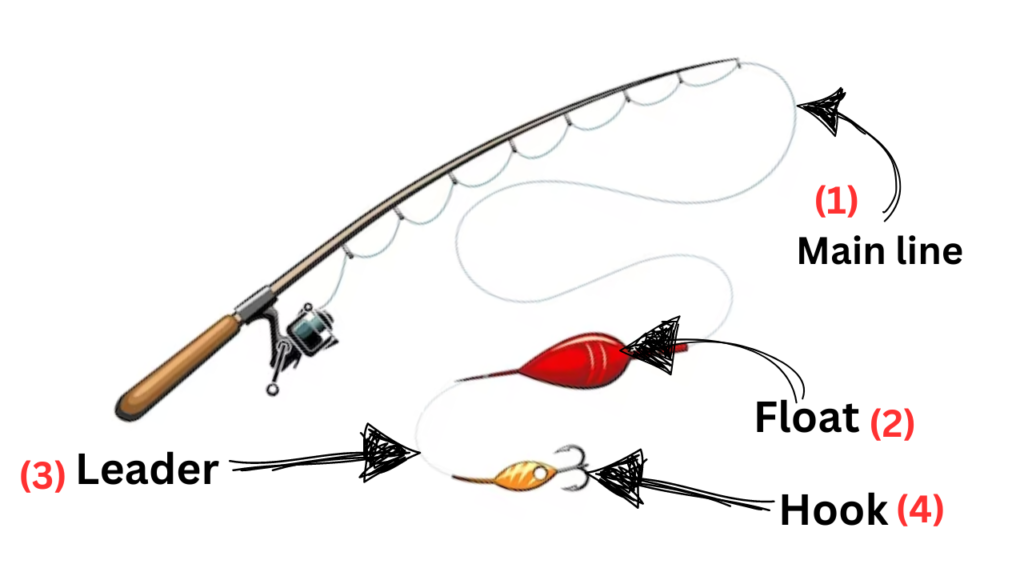
Usually, 6 to 24 inches of the leader is used, but this can vary based on the fishing method. Leaders are interchangeable so you can quickly rig different lengths and strengths.
Types of Fishing Leader Materials
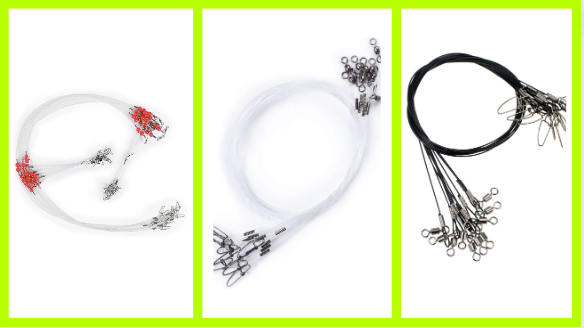
There are three common types of materials used to make leaders:
| Leader Material | Properties | Best Uses |
|---|---|---|
| Monofilament Nylon | Inexpensive, common Good abrasion resistance Low visibility | Toothy fish like pike can bite off other lines |
| Fluorocarbon | Nearly invisible Great sensitivity Excellent abrasion resistance | All-purpose leader for casting, drifting, and bottom fishing |
| Wire | Completely bite-proof Stiff Highly durable | Toothy fish like pike that can bite off other lines |
Monofilament nylon is the standard material for many fishing leaders. It has good abrasion resistance while remaining fairly limp. Fluorocarbon is the top choice when invisibility and sensitivity are critical. Single-strand wire prevents cut-offs from fish with sharp teeth.
Factors in Choosing Leader Strength
You’ll want to match the breaking strength of the leader to the size of the fish you are targeting. A good rule of thumb is to use a leader rated for 8 to 15 pounds of force heavier than the main line strength.
Make sure the leader can withstand the force of a running fish’s initial strikes and surges. Go heavier for species like tuna, wahoo, and sharks that make blistering runs.
Also, consider the type of structure you are fishing. For areas with snags and rocks, use a heavier leader to prevent break-offs if you get hung up.
When targeting wary trout in open water, a lighter 4-6 lb fluorocarbon leader is best.
Recommended Leader Lengths
Leader length is tailored to your specific fishing situation. Use these guidelines for common methods:
- Casting – A 6 to 12-inch leader allows for natural lure action while remaining invisible.
- Drifting – Leaders of 3 to 6 feet keep baits and flies away from the line when drifting or slow trolling.
- Surf fishing – Longer 18 to 24-inch shock leaders prevent casting losses in the waves.
- Offshore fishing – 24 to 48-inch leaders keep baits away from boats when trolling offshore waters.
The more line-shy or clear the water, the longer leader you should use. When fishing heavy covers like grass or timber, shorten your leader length.
Specialized Leader Configurations
Certain types of fishing require tailored leaders to optimize success:

Tapered fly fishing leaders connect the fly line to the fly. A thick butt section transitions to a thin tippet for delicate fly delivery.
Bite tippets are short wire sections added to the end of a leader to prevent cut-offs from toothy fish. They are common for pike and musky leaders.
Surf fishing shock leaders utilize heavy 50-80 lb fluorocarbon or monofilament to absorb the intense stress of long casts. They prevent sudden break-offs.
Wind-on leaders used for offshore trolling consist of monofilament, dacron, or wire over-wrapped on the spool before the main line. This prevents line twists and separation.
Attaching Leaders to Lines and Lures
There are two primary methods for securing leaders:
Leader Knots
The improved clinch, Trilene knot, and uni knot are all excellent for attaching leaders to lines. Use knots like the Rapala knot or Palomar for tying lures and hooks directly to the leader. Knots must be tied correctly and lubricated to ensure full strength.
Swivels and Snaps
Barrel swivels are perfect for quickly connecting leaders to the main line. Ball bearing swivels at the lure allowing it to move freely. Snaps on the terminal end make it easy to change lures. Use high-quality swivels and snaps rated for the target species.
Leaders for Bass Fishing
Bass fishing requires a balance of strength, invisibility, and action.
For casting crankbaits and spinnerbaits, use an 8-12 lb fluorocarbon leader of 10-12 inches. The low stretch provides excellent hooksets.
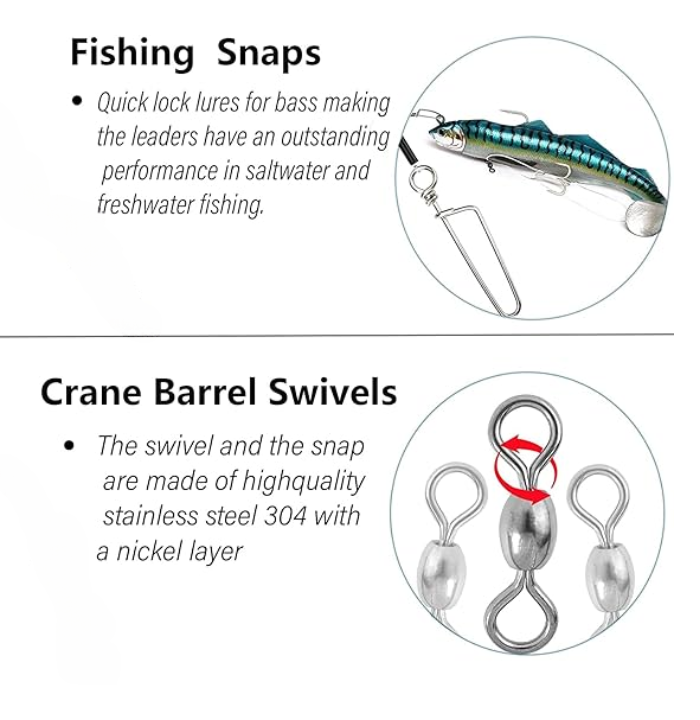
When flipping jigs or soft plastics in heavy cover, a slightly shorter and heavier 15 lb fluorocarbon leader prevents break-offs on hook sets and abrasion from vegetation.
For topwater poppers, a flexible monofilament leader allows better action. Use a lighter 6-10 lb leader to avoid restricting surface lure movement.
Leaders for Walleye Fishing
When trolling or drift fishing open water for walleye, longer leaders help produce more strikes.
For bottom bouncers or drifting live bait rigs, use a 4-6 ft fluorocarbon leader in the 6-10 lb range. The increased action and invisibility get more takes.
When trolling crankbaits, longer 10-20 ft leaders made of tough 12-15 lb monofilament prevent line breaks when a walleye strikes. The mono also gives the lure better action.
Leaders for Surf Fishing
Surf fishing leaders take a lot of abuse from heavy casts and immersion in saltwater.
Strong shock leaders made of 50-80 lb test monofilament are standard. They provide the power to punch baits long distance.
For running fish like stripers, add a 36-inch, 60-lb fluorocarbon bite leader. The low visibility gets more consistent strikes.
When using high-low rigs with multiple hooks, attach each hook to a 20 lb monofilament dropper line approximately 6 inches long. This allows proper bait presentation.
Leaders for Offshore Trolling
Offshore gamefish can slice through standard fishing lines. Robust specialized leaders are required.
When targeting pelagic species like tuna, dolphin, and billfish, use a 5-10 ft wind-on leader made of 200 lb test monofilament. Attach it before spooling on the main line.
For bulldogging big gamefish like marlin, add a 4 ft section of 480 lb test woven dacron leader. It provides an abrasion buffer right before the lure or hook.
When trolling for wahoo and barracuda with razor-like teeth, use a 5 ft single-strand wire bite tippet. It prevents cut-offs from toothy attacks.
Caring for Leaders and Inspecting for Damage
Proper leader storage and inspection will extend the usefulness and prevent losing fish to compromised lines.
Store leaders properly by spooling them on leader caddies, foldable boards, or leader wallets. Never tangle them.
Check for abrasions and weak spots near knots before every trip. Discard leaders with any significant nicks, fraying, or discoloration.
Replace leaders after a big fishfight or if they encounter severe abrasion on rocks, pilings, or other cover. The invisible damage adds up.
Monofilament leaders weaken from UV light damage. Replace them at least once per season, especially if exposed to sunlight.
Frequently Asked Leader Questions
Here are answers to some of the most common leader questions:
Should My Leader Be Stronger Than My Main Fishing Line?
Yes, leaders are designed to be 8-15 lb test stronger than the running line to account for abrasions and fish strikes.
Do I Need A Leader For Freshwater Fishing?
Leaders are highly recommended for all freshwater species to provide durability and stealth.
How Do I Stop My Leader From Twisting?
Use quality ball-bearing swivels in your rigs. Monofilament also resists twisting better than braided lines.
Can I Use The Regular Fishing Line As A Leader?
You can in a pinch, but real leaders provide maximal abrasion resistance and invisibility.
Should I Reuse Old Damaged Leaders To Save Money?
Never reuse an old leader. Replace them frequently as they are a critical component.
Now you should have all the leader knowledge you need to maximize your fishing success and land more fish! Use the right leader materials, lengths, and configurations for any fishing situation.
